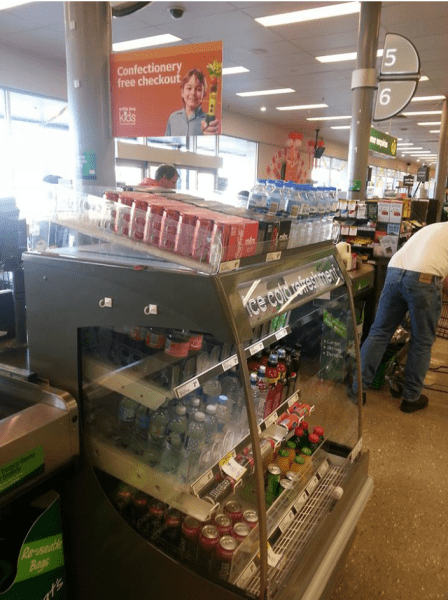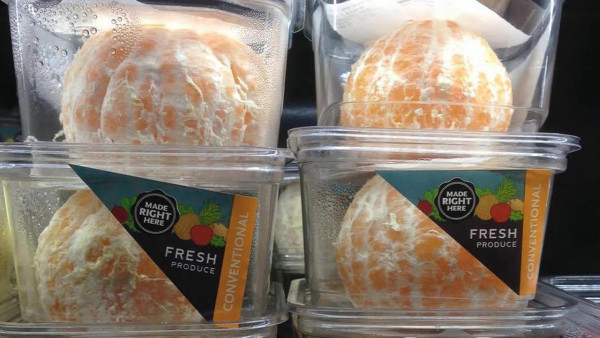The true cost of food
One fine day I was food shopping with my wife at the supermarket. When that joyous time came for it to be over and as we were lining up at the checkout, I noticed a scene. To my right, where usually the checkouts would be drowning in confectionary to lure children like a witch’s ginger bread house, there was paraded the most celebratory banner of a smiling child holding celery, tomatoes and fruit (you know – real food), and a proud statement; “Confectionary free checkout”. Sounds good, doesn’t it? Sounds like leadership? Bamp bownm… (that is my poor attempt to write the stereotypical “wrong answer” noise). Beneath this proud flag flapping in the air-conditioned breeze was…. Coca-Cola! Well not just Coca-Cola, but other soft drinks like V, Mother, and a few bottles of water. Soft drinks aren’t confectionary, right?

This obvious deception raised a few questions in my mind – what is the moral, social, and financial responsibility of food producers and food distributors to society, if any? And in particular, what are the impacts of these on public health?
What comes to mind first is the notion of true cost economics in the context of health. Processed food manufacturers are allowed to sell a product, and they only have to cover the costs of production, distribution, and marketing. They don’t have to cover the costs inherent in the impact of that product. A major UN report concluded that if the biggest global corporations actually paid for the true cost of their business (“externalities” which are the costs that occur to our health, environments, and other areas as a result of their business), then none of them would be profitable. If they actually paid proper tax then they may run at a loss. The cost of pollution and other damage to the natural environment alone caused by the world’s biggest companies would wipe out more than one-third of their profits if they were held financially accountable, with an estimated combined damage worth US$2.2 trillion (£1.4tn) in 20081,2.
So let us go through some of the facts and stats of these costs to public health. In Australia, where we are saturated with calorific choices, many of us are sadly deficient in nutrition. In 2011–12, 4% of Australians experienced food insecurity, as defined by: ‘In the past 12 months, were there any times that you ran out of food and couldn’t afford to buy any more?’. A higher prevalence of food insecurity has been reported among particularly marginalised communities, such as asylum seekers (71%), Aboriginal and Torres Strait Islander peoples (22%), disadvantaged urban households (25%), and people who are unemployed (23%)3.
Australian families that are welfare‑dependent spend 40% of their disposable income in order to afford a nutritious diet, whereas those who are reliant on a ‘Newstart allowance’ have as little as $25 a week for discretionary spending (after fixed costs such as rent and utilities are met)3,4.
Poor nutrition is a major health risk. It contributes to5:
- Almost 50% of CHD deaths
- 33% of all cancer deaths
- Increased falls and fractures in older people
- Low birthweight and increased childhood morbidity and mortality
- Increased dental caries in children
There is also growing evidence to support the link between poor diets and anti-social behaviour. In a placebo controlled study in a male prison, vitamin, mineral, and essential fatty acid supplements were associated with a decrease of 37% in serious incidents5. Food relief organisation, ‘SecondBite’, reports that the most food insecure are 20-40% more likely to suffer from obesity due to their reliance on cheap, calorific, fast food6. This is a sad state indeed considering the amazing produce we have available to us, and the dedication of our farmers.
It doesn’t end with food producers. Food distributers, retailers, and even consumers (yes, that is us), are just as guilty when it comes to a lack of social responsibility. However, in this respect, it is about food waste and packaging. An estimated 20-40% of fruit and vegetables are rejected BEFORE they even reach the shops, mostly because they do not match the supermarkets cosmetic standards (think wonky carrots). Australians discard 20% of the food they purchase, which is 4 million tonnes of food a year. If you add up all the food Australia wastes per year, it would fill 450,000 garbage trucks7. The wonky carrots are a good case in point because there is no logical reason these cannot be sold and consumed. In France, under new legislation, supermarkets will have to take measures to prevent food waste, and will be forced to donate any unsold but still edible food goods to charity, or for use as animal feed or farming compost8. This is just one example of what could be done in Australia.
Let’s talk food packaging (I shall leave no plastic bag left unopened!). There is growing evidence that food can be contaminated by harmful chemicals from some types of plastic, like polycarbonates bisphenol A (BPA), phthalates, and epoxidised soybean oil (ESBO), which are known endocrine disruptors. Canada, the European Union, and some states of the US, have phased out the use of BPA in some products. In 2008, the Productivity Commission recommended that the Australian Government establish a program to identify and deal with the risks of chemicals in consumer articles, but to date, there has been little action, with the plastics industry fighting off tighter regulation9.
Then there are the environmental implications of food packaging, which are huge and very costly to the public system, but outside the scope of this article to discuss.
Let us not be naïve – there are reasons food packaging exists. It sells products. Of course it also makes highly processed foods stay sellable, and maintains it for long term storage – tight and snuggly like a new born baby wrapped in an unchanged nappy. There is a type of food packaging I have much more patience for – natural fruit and vegetable peels. Sadly though, even nature’s wrapping is being replaced by convenience, as is so depressingly expressed in this photo:

Though coming back to the selling point – it is an interesting yet challenging fact that packaging sells. That is its purpose. That cheeky smiling monkey selling “2 star” cereal “loved for generations” (their words, not mine), appeals to us over a bowl of steamed vegetables for breakfast. NB: the new star rating system for food is another topic, but this comedic clip from the ABC ‘Checkout’ team is a nice summary.
For us as consumers, all this is said in the spirit of encouraging a positive change as a result of being challenged by facts. However, for those of us who are also in business and health, it comes down to a simple principle: true cost economics. Private industry, when done well, is extremely important and valuable as it provides jobs, purpose, and progress. However, when the private processed food producers and retailers are allowed to make huge profits at the expense of our worthy farmers and the public funds in all health, environmental, and social portfolios, it hardly seems logical or right. It is not about restriction though – this is about an opportunity that now exists whereby all sectors can cooperate to develop an industry that produces financial, environmental, and social benefits. You know, like French wonky carrots.
- www.theguardian.com/environment/2010/feb/18/worlds-top-firms-environmental-damage
- www.trucost.com/publication/natural-capital-risk-top-100-externalities-business
- www.racgp.org.au/afp/2015/november/food-insecurity-in-australia-implications-for-general-practitioners
- www.preventioncentre.org.au/our-work/research-projects/is-price-a-barrier-to-eating-healthy-food
- www.fph.org.uk/uploads/bs_food_poverty.pdf
- www.sydney.edu.au/news-opinion/news/2016/04/11/-the-right-to-food—and-how-1-2-million-australians-miss-out.html
- www.foodwise.com.au/foodwaste/food-waste-fast-facts
- www.smh.com.au/world/france-to-ban-food-waste-in-supermarkets-20150522-gh79uh.html
- www.choice.com.au/food-and-drink/food-warnings-and-safety/plastic/articles/plastics-and-food



